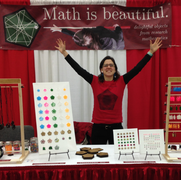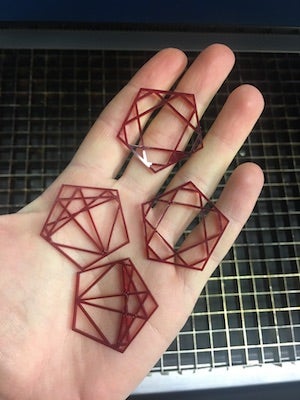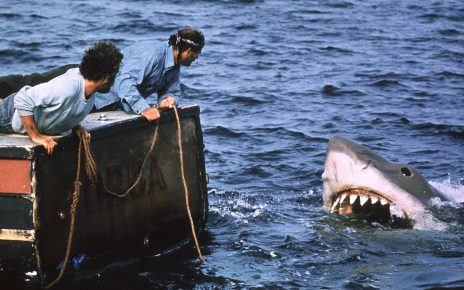Swarthmore College mathematician Diana Davis, whom I am lucky enough to call a friend, is multitalented. Her combined love of math and running led to an earlier appearance in this blog, where she investigated the question of whether, if you run a marathon at, say, a 7:00 minute per mile pace, must you have run any mile in exactly 7 minutes? Recently, she has been making jewelry, clothing, coasters, and other objects based on her research involving billiard trajectories in pentagons. I asked her about her research and the beautiful things she has made from it. You can find her creations in person at conferences including the Joint Mathematics Meetings or explore her website.
First, introduce yourself. Where are you from, where did you go to school, and where do you work now? Apart from math, what are you passionate about?
I’m originally from New Hampshire. I went to Williams College for undergrad and to Brown University for my Ph.D. I’m currently a visiting assistant professor at Swarthmore College. Apart from math, I’m passionate about good teaching, fairness in all things, and long-distance running.
What is your research area, and what are some of the math questions you like to think about?
My research is in dynamical systems, primarily in billiards, which is the study of a ball (or point) bouncing around in a shape (usually a polygon, and often a pentagon). People have understood billiards on the square for over a hundred years, and that’s about it: as humans, we don’t understand billiards on any other shape, except maybe a couple of special triangles (equilateral, isosceles right, that sort of thing). So I want to know what happens with billiards on tables that are other polygonal shapes.

The question that drove me for many years was: suppose you have a ball on a regular pentagon billiard table, and you choose a direction to hit your ball, and you know that the ball’s path is going to be periodic: the ball will bounce around for a while, and then return to where it started and repeat. How many times will it bounce before it repeats — how can you get this information from the direction? For the square, if the slope of the path (assuming the edges of the table are horizontal and vertical) is rational, then you know the path will be periodic, and if the slope is p/q in lowest terms, then the ball will bounce 2(p+q) times before it repeats. It’s a beautiful result, and I wanted to generalize it to the regular pentagon.
What’s so great about pentagons? Did you love them before they got to be such a big part of your work, or did your love for pentagons grow as you researched them more?
Five has always been my favorite number. This is not why I studied the pentagon. The main reason to study it is that it’s, in some sense, the “next-simplest” regular polygon after the square — after all, a square has 4 sides and a pentagon has 5. Arguably, though, the regular octagon is a little simpler, because it’s just a square with the corners cut off. Indeed, John Smillie and Corinna Ulcigrai had done some work on the regular octagon, and my Ph.D. advisor told me to read their paper about the octagon, and see if I could use the same strategies to understand the regular pentagon. Indeed I could! So that’s how I got started with the pentagon. In that case, I was actually studying a surface made from two pentagons, which you can see in my viral dance video.
Cutting Sequences on the Double Pentagon, explained through dance from Diana Davis on Vimeo.
Then I was at a conference in Oberwolfach in spring 2014, and Samuel Lelièvre came up to me. He told me that he liked my video about the double pentagon surface, and that we should work together to understand billiards on the regular pentagon billiard table. We’ve been working on it ever since.
How did you get the idea to start making pretty things based on your work, and what pretty things do you make right now?
In summer 2017, I was working in Moon Duchin’s research cluster at Tufts University. She let us take time out to get trained on the equipment in Tufts’s Makerspace. Before that, I had no interest in laser cutters or any kind of Makerspace activities, but after I learned how to use them, suddenly I wanted to try all kinds of things. The first things I made were coasters — plastic pentagons about 5 inches across, engraved with periodic billiard trajectories. But although coasters are easy to make, there is really low demand for coasters. I imagine that many people have about five or ten times as many coasters as they actually use.

One day, I had the idea to make some earrings, probably just for my roommate — I don’t have pierced ears, myself — and I made a couple of tester pairs. As soon as I had that idea, and the test pairs turned out well, I realized I was really onto something. You see, almost everyone wears earrings. I didn’t realize that when I started this project — again, I don’t have pierced ears — but I’ve found that about 90% of (women) mathematicians have pierced ears. And, unlike with coasters, people are always happy to have another pair of earrings.
The great thing about earrings is that they are a good conversation starter. I have a hard time talking to new people. So my new strategy is that if there is someone I want to talk to, I walk up to them, open my box of earrings, and offer them a pair. The earrings are beautiful, so the person is generally happy about this offer, and things work out great. What’s more, people usually ask follow-up questions, like “what are the patterns?” and “this is your research?! What is your research about?” which, to put it lightly, is not the response you usually get when you tell the person next to you on the airplane that you are a mathematician. My reach goal is to put stealth mathematics into popular culture. I would love for a normal retailer to carry my earrings, the way that they carry Alex and Ani bracelets and that sort of thing, and people would buy them because they are beautiful, and no one would even know that they are mathematical. Maybe that could be a rumor that came out later, in the tabloids. On the other hand, I named my earring company “Math is beautiful,” which is stealth advertising for math, because when people talk about my fledgling company, I have tricked them into saying “math is beautiful” out loud.
These days I am making a couple of things. For the earrings, the prettiest thing I am doing is using translucent colored plastic, and cutting out the negative space, where the trajectory isn’t. I also take sheets of solid wood and engrave a trajectory on one side, and then some information about the trajectory, such as ‘101 short trajectory’ on the other side. I give these away before my talks, and then people ask, “what is 101? what does ‘short trajectory’ mean?” and I say, “come to the talk!” Then people have a reason to pay attention to the various parts of the talk, so that they can understand the information on the back, and they also get something to take home with them. [Readers can check out Davis’s and Lelièvre’s paper about these trajectories here.]

Unrelated to my research, I have been cutting out tiling lizards, based on Escher’s woodcut from 1943. I keep them on my table, and it is extremely satisfying to put them together like a puzzle, as they snap into place with a satisfying click. My students love them, and it helps them to have something to do with their hands when they talk with me.
How did you learn what you needed to learn to actually start making things, and how did you get access to the right equipment?
I learned the basics of laser cutting at Tufts’s Makerspace. Then I started working at Swarthmore a few months later, and I was delighted to find that there was also a laser cutter here. I did all of my experimenting with materials and methods here at Swarthmore, and as with most things, I learned by trying things, having failures, and trying something else.
If you want to laser cut things, it’s important to have access to someone else’s laser cutter, rather than owning your own. A laser cutter is the size of a chest freezer, costs about $40,000, needs to have direct venting to outside (so it can’t be in a basement or an interior room), and can easily start fires or explode if left unattended. They also need frequent maintenance. For these reasons, it is great to be able to use someone else’s machine.



